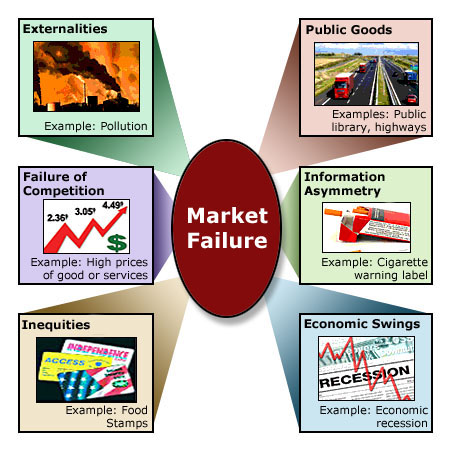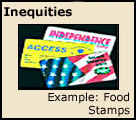Main Content
Lesson 2: Principles of Public Finance - The Role of Government
Theories of Market Failure

The theories of market failure provide a theoretical justification for government intervention and the role of government in the economy.
The theory of market failure can briefly be described as a set of economic theories that seek to explain why free markets sometimes fail to allocate goods and services in a way that maximizes a society's welfare. Or, worded differently, they seek to explain why individuals' pursuits of pure self-interest sometimes result in a situation where a society's limited resources could have been used better.
Economists are often concerned with the causes of market failures and possible means to correct such failures when they occur. As indicated on the previous page, a possible corrective measure is to rely on the public sector to rectify these failures. Toward this end, the theories of market failure provide a theoretical justification for government intervention and the role of government in the economy.
Government Intervention in the Economy According to Musgrave
On the remainder of this page, we will review the role that the public sector ought to have in the economy, according to Richard A. Musgrave (1910-2007). Musgrave is significant for the purposes of this lesson because of the important role he played in shaping modern public finance. In fact, he is referred to by many as the father of modern public finance. He earned this title, largely as a result of his book The Theory of Public Finance (1959), which provided the first English-language, comprehensive account of public finance. In this book he outlines three basic types of economic activities in which government intervention can be justified based on the theories of market failure. These economic activities are
- allocation of resources,
- distribution of goods and services, and
- economic stabilization.
To familiarize yourself further with Musgrave, read the assigned article, "Richard A. Musgrave, 96, Theoretician of Public Finance, Dies," written by Walsh and published in the New York Times. (Note: You can also access the article via the library e-reserves.) It provides a general overview of Musgrave’s contributions to public finance. A more detailed description of the three types of economic activities listed above is provided in Chapter 1 of the Mikesell textbook. As you read this chapter, try to imagine additional examples of public sector activities (beyond those provided in the textbook) in each of the three functional areas mentioned.
Six Failures

As you read Chapter 1 in the Mikesell book, you will find that the chapter provides a more detailed account of how the existence of various market failures can be used to justify government involvement in the above three functional areas. In essence, the article proposed that free markets, when left to their own devices, fail to allocate goods and services efficiently due to one of six types of failures. These failures are illustrated in Figure 2.1: Six Failures.
As you will find when reading the Mikesell text, these six failures give rise to a range of problems that governments are expected to correct.
While these problems are exemplified and described in more detail in the textbook, they are briefly described as follows (you can navigate each failure by clicking the circle or arrow icon):

 1. Externalities
1. Externalities  2. Failure to Provide Public Goods
2. Failure to Provide Public Goods  3. Failure of Competition
3. Failure of Competition  4. Information Asymmetry
4. Information Asymmetry  5. Inequities
5. Inequities  6. Economic Swings
6. Economic Swings